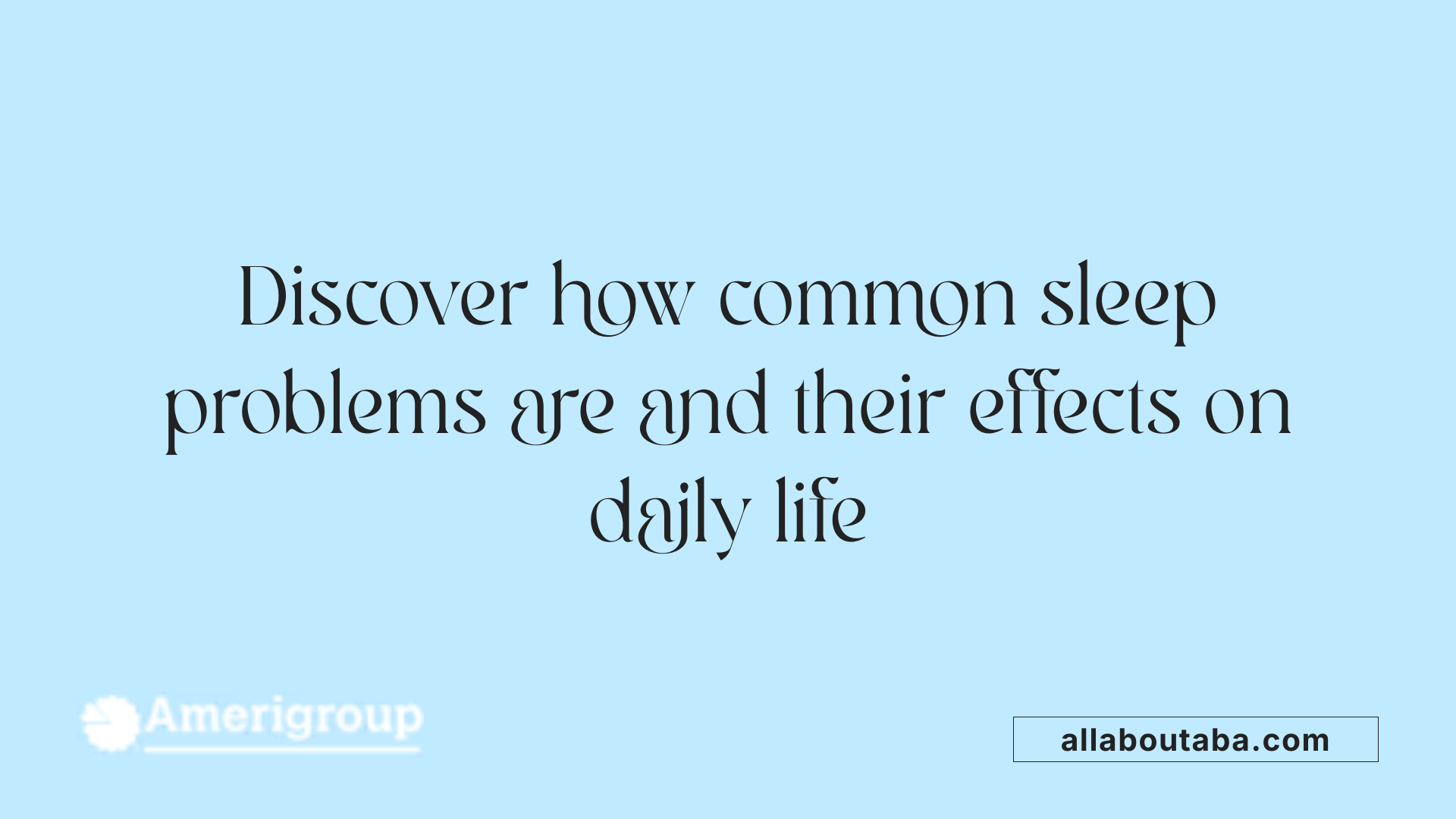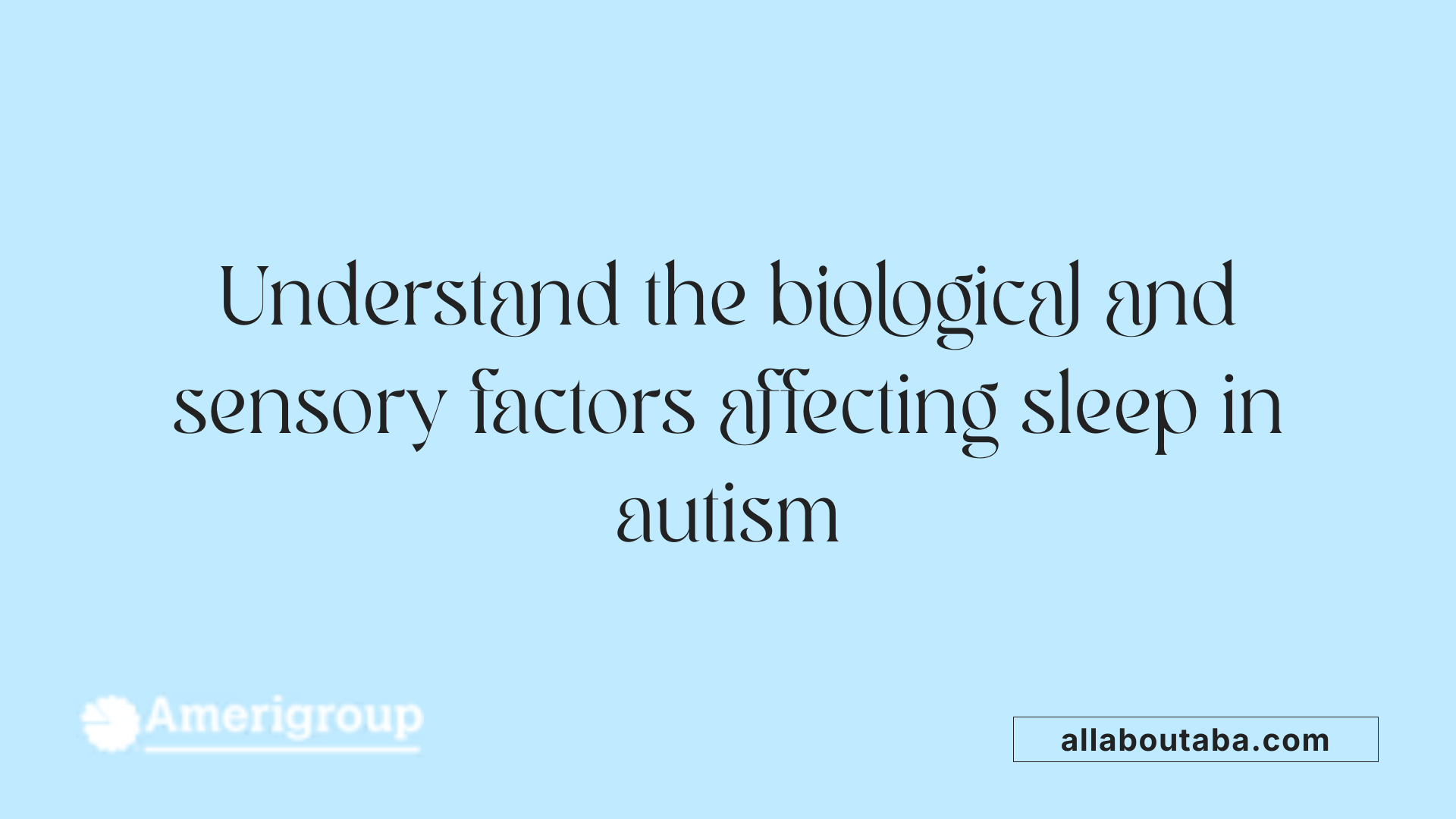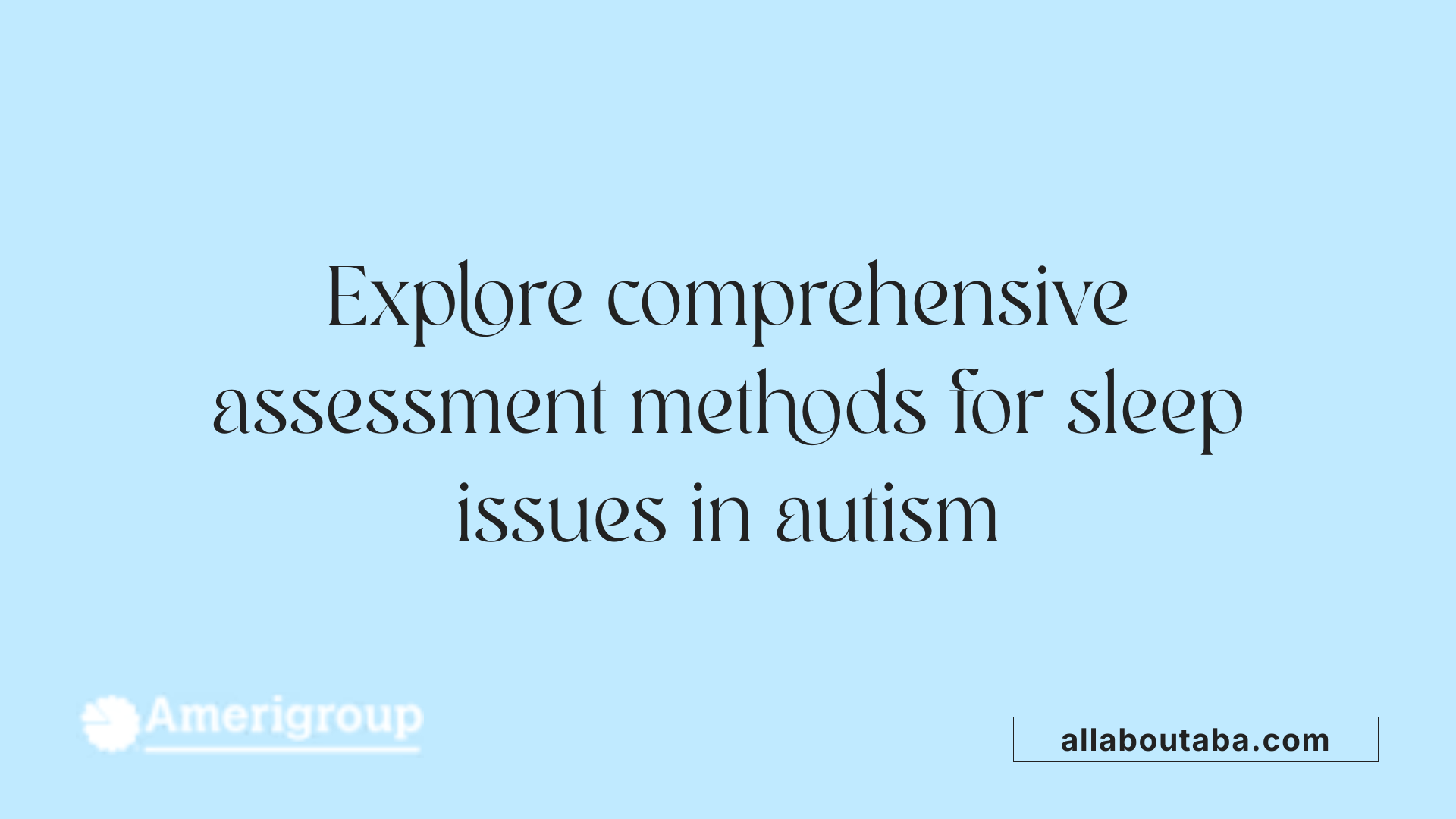Addressing Sleep Regression In Children With Autism
Introduction to Sleep Challenges in Autism
Sleep regression is a common concern among children with autism spectrum disorder (ASD), significantly impacting their behavior, learning, and overall quality of life. With prevalence estimates between 50% and 80%, sleep problems in autistic children are notably higher than in their neurotypical peers. Addressing these issues requires understanding their causes, identification, assessment, and implementing evidence-based interventions tailored to each child's needs.
Prevalence and Impact of Sleep Problems in Children with Autism

What are common sleep problems and challenges faced by children with autism?
Children with autism often struggle with a variety of sleep disturbances. The most common issues include difficulty falling asleep, frequent night awakenings, short sleep duration, and waking up too early in the morning. Many also experience irregular sleep patterns, night terrors, nightmares, and restless movements during sleep such as body-rocking or head-banging.
These sleep problems are significantly more common in children with autism than in their neurotypical peers. In fact, estimates suggest that between 50% and 80% of children on the spectrum face chronic sleep difficulties, compared to about 25% in typical development. The high prevalence is linked to intrinsic neurobiological differences, including irregular melatonin production, circadian rhythm disturbances, and sensory sensitivities.
Factors contributing to these difficulties include anxiety, restricted and repetitive behaviors, sensory issues, and exposure to stimulating or frightening media. Medical conditions like sleep apnea, gastrointestinal problems, or co-occurring conditions like ADHD can also exacerbate sleep issues.
Addressing sleep challenges is crucial because poor sleep impacts many areas of life. Sleep problems tend to worsen behavioral challenges such as hyperactivity and irritability, interfere with learning and academic performance, and diminish overall quality of life for both children and their families.
Strategies to improve sleep span behavioral techniques, environmental adjustments, establishing consistent routines, and sometimes pharmaceutical interventions like melatonin. A tailored approach, often supported by healthcare professionals, can significantly enhance sleep quality, which in turn can lead to better behavior, improved learning, and greater well-being for children with autism.
Causes and Contributing Factors of Sleep Issues in Autism

What are the causes and contributing factors of sleep issues in children with autism?
Children with autism often experience sleep difficulties due to a variety of interconnected factors that involve biology, sensory sensitivities, behaviors, and health conditions.
One major contributor stems from neurobiological differences. Research suggests that children with autism may have anomalies in brain wave organization and delays in brain maturation. These differences can interfere with the natural sleep-wake cycles, making it harder to fall asleep or stay asleep. Moreover, genetic factors linked to circadian rhythm regulation, including mutations in genes responsible for melatonin production and receptor function, play a significant role. Melatonin, a hormone that helps regulate sleep, is often produced irregularly or at abnormal levels, further complicating sleep patterns.
Sensory dysregulation is another key factor. Many autistic children have heightened sensitivities to light, sound, touch, or other sensory inputs. This hyper-reactivity can lead to hyper-arousal, which inhibits the ability to relax and transition into sleep. Excessive sensory input or discomfort from an unoptimized sleep environment may keep children awake or cause frequent night awakenings.
Behavioral routines and daytime habits also influence sleep quality. Irregular bedtimes, inconsistent routines, and excessive screen time before bed can disrupt sleep onset. Anxiety, common in children with autism, can also cause difficulty winding down, leading to prolonged sleep latency.
Lastly, some medical conditions prevalent among children with autism contribute to sleep problems. Conditions such as obstructive sleep apnea, gastrointestinal issues like reflux or constipation, and night terrors can all interfere with restful sleep.
Understanding these factors helps caregivers and clinicians develop targeted strategies for intervention. Establishing regular routines, creating sensory-friendly environments, addressing medical health, and considering pharmacological aids like melatonin can collectively improve sleep outcomes in children with autism.
Identifying Sleep Regression in Autism
How can sleep regression in children with autism be identified?
Sleep regression in children with autism is often noticeable through abrupt changes in their usual sleep patterns. Parents and caregivers might observe that the child is having difficulty falling asleep or is waking frequently during the night. Early waking or shortened sleep durations—sometimes less than seven hours per night—are also common signs.
These disruptions tend to coincide with developmental milestones or environmental transitions, such as starting school, changes in routine, or heightened anxiety. Children experiencing sleep regression may also show increased behavioral challenges, emotional outbursts, or sensory sensitivities.
Parents often notice that their child’s bedtime becomes more difficult, with an increase in night wakings or stubborn resistance to going to sleep. Such behaviors reflect a disruption in their established sleep routines.
Medical evaluations, including sleep studies, can help uncover underlying conditions like sleep apnea or reflux that might contribute to sleep problems. Behavioral assessments focus on analyzing routines, sleep hygiene, and environmental factors that may be affecting sleep quality.
Using tools like sleep diaries allows parents to track sleep habits, identify patterns, and pinpoint triggers for regression. Regular observations and recording sleep behaviors are instrumental in early identification.
Overall, recognizing these signs early enables targeted interventions such as behavioral strategies, environmental modifications, or medication like melatonin. Doing so can improve sleep quality and reduce the impact of sleep regression on overall behavior and development.
Assessment Techniques for Sleep Problems

What assessment methods are used to identify sleep problems in children with autism?
Identifying sleep issues in children with autism requires detailed evaluation using various assessment tools. Both subjective and objective methods are employed to gain a comprehensive understanding of the child's sleep patterns and underlying causes.
Subjective assessment methods include sleep diaries kept by parents or caregivers. These diaries record bedtime routines, sleep onset latency, night wakings, and morning wake times over several days or weeks. Questionnaires like the Children’s Sleep Habits Questionnaire (CSHQ), the Family Inventory of Sleep Habits, and the modified Simmonds and Parraga Sleep Questionnaire provide structured insights into sleep behaviors, environmental influences, and daytime consequences.
On the other hand, objective tools offer measurable data. Polysomnography, or sleep studies, are considered the gold standard for diagnosing sleep disorders like sleep apnea and seizure-related sleep disturbances. This overnight evaluation records brain activity, breathing, heart rate, and limb movements.
Actigraphy involves wearing a wrist device that uses accelerometry to monitor sleep-wake activity patterns continuously over days or weeks. It provides reliable data on sleep duration, efficiency, and circadian rhythm disruptions. Supplementing actigraphy with videosomnography—video recordings during sleep—can help observe behaviors such as body movements or unusual activities that may influence sleep quality.
Combining these assessment methods enables clinicians to develop a detailed picture of the child's sleep profile. This holistic approach helps identify behavioral issues, medical conditions, sensory sensitivities, and neurobiological factors contributing to the sleep problems. Accurate diagnosis is crucial for tailoring effective intervention strategies, whether behavioral, environmental, or pharmacological, to improve sleep health in children with autism.
Evidence-Based Interventions for Sleep Issues

What evidence-based interventions are available to address sleep problems in children with autism?
Children with autism often face challenges with sleep, including difficulties falling asleep, staying asleep, or waking up too early. To help improve sleep, various interventions grounded in research are recommended.
One of the most effective approaches involves behavioral strategies. Establishing consistent bedtime routines is crucial. This can include calming activities such as reading or gentle massage that signal to the child that it is time to sleep. Using visual supports like picture schedules and alarms can also promote understanding and predictability, helping children know when it’s time to settle down.
Creating a calming sleep environment supports these routines. This might involve dimming lights, maintaining a cool room temperature, and reducing noise and sensory stimulation. Positive reinforcement—for example, praising or providing small rewards when the child follows the bedtime routine—can encourage successful sleep behaviors.
Sleep hygiene practices are essential components of treatment. Maintaining a regular sleep schedule helps stabilize circadian rhythms. Avoiding screens and stimulating activities for at least an hour before bed reduces arousal levels. Additionally, minimizing stimuli such as loud noises or bright lights in the bedroom fosters a peaceful setting.
Sensory management techniques are also beneficial. Weighted blankets and compression sheets can provide calming input for children with sensory sensitivities. These tools help reduce hyperarousal and promote relaxation, making it easier for children to fall asleep.
When behavioral and environmental modifications are not enough, pharmacological options like melatonin are often used. Melatonin, especially pharmaceutical-grade, helps regulate sleep-wake cycles and has been shown to improve sleep onset and duration in children with autism.
In addition, addressing co-occurring conditions like anxiety or sleep apnea can improve overall sleep quality. Relaxation techniques, scheduled awakenings for sleep apnea, or medical treatment for underlying issues are important parts of a comprehensive approach.
Implementing these evidence-based interventions can significantly improve the sleep of children with autism, leading to better daytime behavior, mood, and overall well-being.
| Intervention Type | Techniques | Additional Details |
|---|---|---|
| Behavioral Strategies | Routines, visual supports, positive reinforcement | Promotes cooperation and predictability |
| Sleep Hygiene | Regular schedule, limit screens, environment control | Establishes healthy sleep habits |
| Sensory Management | Weighted blankets, compression sheets | Addresses sensory sensitivities |
| Pharmacological Treatment | Melatonin | Used when other methods are insufficient |
Effective management of sleep involves combining these approaches tailored to the child's needs, ideally under guidance from healthcare and behavioral specialists.
Strategies to Improve Sleep Hygiene and Environment
What strategies can help improve sleep in children with autism?
Improving sleep in children with autism involves a combination of behavioral, environmental, and sensory approaches. Establishing consistent bedtime routines is essential. Using visual cues like social stories or visual schedules helps children recognize and follow the bedtime sequence, signaling that it’s time to sleep and reducing bedtime resistance.
Creating a sleep-friendly environment plays a critical role. The bedroom should be dark, quiet, and kept at a comfortable, cool temperature. Removing clutter and toys that might overstimulate can help make the space more calming. For children sensitive to sensory input, tools such as weighted blankets, compression sheets, or soft bedding made from sensory-friendly fabrics can reduce discomfort and promote relaxation.
Addressing sensory sensitivities is vital. Some children benefit from sensory assessments to identify specific triggers. Incorporating calming sensory activities before bed, like gentle massage, deep-pressure touch, or soothing music, can ease arousal levels.
Managing anxiety and hyperactivity through relaxation techniques is another effective strategy. Techniques such as deep breathing exercises, progressive muscle relaxation, and mindfulness can help children calm their minds and bodies before sleep. Engaging in regular, age-appropriate physical activity during the day can also reduce restlessness at night.
Gradually fading sleep associations—like falling asleep with a parent—by encouraging independent sleeping skills helps prevent sleep disruptions caused by dependence on certain stimuli.
It’s advisable for parents to consult with healthcare professionals about behavioral strategies and proper sleep hygiene practices. In some cases, healthcare providers may recommend pharmacological options such as melatonin to support sleep, especially when behavioral modifications alone are insufficient.
Incorporating these strategies collectively can significantly improve sleep quality, leading to better overall health, behavior, and developmental outcomes for children with autism.
Medication Support for Sleep in Autism

Can medications like melatonin be used for managing sleep issues in children with autism?
Yes, medications such as melatonin are frequently recommended for children with autism spectrum disorder (ASD) experiencing sleep problems. Melatonin is a naturally occurring hormone that helps regulate the sleep-wake cycle, and supplementing it can address irregularities in melatonin production common among autistic children.
Research studies have consistently supported the use of melatonin to improve sleep parameters in this population. It has been shown to increase total sleep duration, reduce time taken to fall asleep (sleep onset latency), and decrease night wakings. Many parents report significant improvements not only in their child's sleep but also in daytime behaviors, mood, and overall functioning.
In terms of formulations, pharmaceutical-grade melatonin is preferred because it ensures safety, purity, and consistency. There are various forms available, including immediate-release and prolonged-release melatonin. Prolonged-release formulations, which mimic the body's natural melatonin secretion, have demonstrated promising results, especially for children who wake early or have difficulties maintaining sleep.
Dosing recommendations typically vary from 0.5 mg up to 15 mg administered approximately 30 minutes before bedtime. The actual dose should be tailored to each child's needs and always under medical supervision to minimize potential side effects.
Guidelines emphasize that pharmacological treatment, including melatonin, should be considered only after behavioral and environmental strategies have been attempted. It is also crucial to screen for any underlying medical or biological factors that contribute to sleep difficulties.
Long-term safety data for melatonin in children with ASD are encouraging, with few reported adverse effects. Nevertheless, ongoing monitoring and consultation with a healthcare provider are essential to ensure safe, effective use.
In summary, melatonin is a valuable tool in managing sleep issues within autism treatment plans, serving as a safe and effective adjunct when behavioral strategies alone are insufficient.
Guidelines and Parental Support for Managing Sleep Challenges

What guidelines can help parents and caregivers manage sleep challenges in children with autism?
Managing sleep difficulties in children with autism involves a combination of behavioral strategies, environmental adjustments, and, when necessary, medical interventions. Consistency is fundamental — establishing predictable bedtime routines helps signal the body that it is time to wind down. Visual tools such as visual schedules or alarms can support children in understanding and adhering to these routines.
Creating a calming and sensory-friendly sleep environment is also crucial. This may include using weighted blankets or compression sheets to provide calming pressure, although their effectiveness can vary depending on individual sensory preferences. Minimizing environmental stimuli, such as reducing noise and light, helps promote better sleep.
Behavioral approaches form the foundation of first-line interventions. These include implementing good sleep hygiene — like avoiding stimulating activities before bed, limiting screen time, and maintaining a consistent sleep schedule. Techniques such as stimulus control protocols, fading bedtime, and relaxation methods like massage and deep breathing are effective tools.
If these behavioral strategies do not suffice, consulting healthcare providers is important. Professionals trained in autism and sleep management can evaluate for underlying medical conditions such as sleep apnea or restless sleep. They may recommend pharmacological options like melatonin, which has substantial evidence backing its safety and effectiveness in regulating sleep. It's essential to work with a medical provider to choose pharmaceutical-grade melatonin and determine appropriate dosing.
Furthermore, addressing coexisting medical issues, like obstructive sleep apnea, can significantly improve sleep quality. Screening for symptoms such as snoring, gasping, or unusual night behaviors should prompt a medical consultation.
In summary, managing sleep in children with autism requires a comprehensive approach that combines consistent routines, sensory modifications, behavioral techniques, and professional guidance. This holistic strategy not only enhances sleep but also contributes to better daytime behavior and overall well-being.
Current Scientific Understanding and Ongoing Research
What is the current scientific understanding of sleep problems in children with autism?
Research indicates that sleep disturbances are a common concern among children with autism spectrum disorder (ASD), with prevalence estimates as high as 80%. These sleep issues include difficulty falling asleep (prolonged sleep onset latency), frequent night awakenings, short overall sleep duration, and early morning awakenings. These problems often persist into adolescence and adulthood, significantly affecting daily functioning and quality of life.
Objective assessment tools such as sleep diaries, validated questionnaires like the Children’s Sleep Habits Questionnaire, and sleep monitoring devices like actigraphy help identify specific sleep challenges in this group. These tools reveal that children with ASD typically experience reduced sleep efficiency, increased sleep latency, and uneven sleep patterns compared to neurotypical children.
Underlying these sleep issues are neurobiological factors. Abnormal melatonin production, circadian rhythm disturbances, and brain wave irregularities have been identified as contributing causes. For example, some children with ASD exhibit irregular melatonin levels, which disrupt sleep-wake cycles, while anomalies in brain wave organization may interfere with normal sleep architecture.
Understanding these biological mechanisms underscores the importance of tailored interventions. Behavioral strategies including establishing consistent routines, creating soothing sleep environments, and using calming techniques are first-line approaches. When these prove insufficient, pharmacological options such as pharmaceutical-grade melatonin are considered, supported by promising research on their short-term efficacy.
Ongoing research continues to explore how genetic factors—like circadian gene anomalies—affect sleep patterns and how neurobiological differences further contribute. Scientists are also examining the effectiveness of combining behavioral approaches with medication and new therapies aimed at modulating sleep-related neurochemical systems.
By integrating objective assessments with an understanding of underlying biological factors, clinicians can develop more precise, individualized treatment plans. Current studies aim to improve intervention strategies, enhance sleep quality, and ultimately improve the overall health and daily functioning of children with autism.
Educational Resources and Support Tools for Caregivers
Are there educational resources and tools available to support sleep management in children with autism?
Yes, there are a variety of educational resources and tools designed to help caregivers improve sleep for children on the autism spectrum. Reputable organizations like Autism Speaks and the Autism Treatment Network (ATN) have developed comprehensive online programs, toolkits, and guides that provide evidence-based strategies for managing sleep issues.
One notable resource is the 'Strategies to Improve Sleep in Children with Autism,' which offers caregivers detailed guidance on establishing consistent routines, creating sensory-friendly environments, and implementing behavioral strategies. The 'At Home Sleep Toolkit for Parents of Children with Autism' includes visual schedules, quick tip sheets, and downloadable materials to support effective bedtime routines.
These programs often feature videos demonstrating techniques such as calming activities, sensory management, and how to use tools like weighted blankets or visual alarms. They also address the appropriate use of melatonin, setting realistic sleep goals, and managing anxiety around sleep.
Training in behavioral routines and sleep hygiene is a major component. For example, caregivers learn how to set up predictable bedtime routines, limit stimulating activities before bed, and encourage independent sleep. Sensory management strategies, like reducing noise and light, are also emphasized.
Furthermore, many resources provide guidance on supporting families through community services and support groups, fostering a shared learning environment. These tools are grounded in research and clinical experience and aim to empower caregivers with the knowledge to improve their child's sleep health effectively.
Overall, these educational tools are accessible online, easy to navigate, and tailored specifically for children with autism, making them valuable assets for parents and professionals working on improving sleep outcomes.
Conclusion: A Multidimensional Approach to Sleep Regression in Autism
Addressing sleep regression in children with autism requires a comprehensive, individualized approach involving behavioral strategies, environmental adjustments, medical evaluations, and, when necessary, pharmacological support like melatonin. Early identification of sleep disturbances through vigilant assessment and ongoing monitoring is crucial. Combining evidence-based interventions, caregiver education, and community resources optimizes sleep outcomes, thereby enhancing the child's overall development and family wellbeing. Continued research into the neurobiological mechanisms and tailored treatments promises to improve management strategies further, offering hope to families navigating the complexities of sleep issues in autism.
References
- Sleep | Autism Speaks
- Recommendations for Identifying Sleep Problems and Treatment ...
- Addressing Sleep Issues in Children, Teens With Autism
- Sleep in Children with Autism Spectrum Disorder - PMC
- Sleep problems and solutions: autistic children
- Autism and Sleep: Common Issues and Solutions
- Top 6 Strategies for Addressing Sleep Issues in Children with Autism
- Insomnia in children affected by autism spectrum disorder: The role ...
Other articles
Recent articles

Best Practices For Autism-Friendly Fitness And Recreation Centers

Best Ways To Promote Healthy Social Media Use For Autistic Teens

How To Help Autistic Children Cope With Public Speaking

Autism And Strategies For Managing Unexpected Changes

Best Podcasts About Autism For Parents And Educators

Autism And The Impact Of Seasonal Changes On Behavior

The Role Of Diet In Managing Co-Occurring Conditions With Autism

Sleep Challenges In Autism And Practical Solutions

Best Ways To Build Daily Routines For Autistic Children

Best Practices For Supporting Autistic Entrepreneurs

Autism And Strategies For Navigating Large Social Gatherings

Adaptive Sports And Recreational Activities For People With Autism

Autism And The Benefits Of Story-Based Learning Activities

Understanding The Role Of Play In Autism Development

Autism And The Impact Of Environmental Noise On Learning

How To Create Autism-Friendly Community Spaces

Autism And Chronic Health Conditions: What To Know

The Role Of Care Managers In Autism Life Planning

How To Teach Social Boundaries To Autistic Children

How Autistic Individuals Experience Empathy Differently

How To Support Autistic Employees In Remote Work Settings

Autism And The Relationship Between Motor Skills And Learning

How To Create Community Resource Guides For Autism Families

How To Teach Daily Living Skills To Autistic Teens

Autism And The Impact Of Mind-Body Practices On Stress Reduction

Autism And The Benefits Of Outdoor Group Activities

How To Create Autism-Friendly Sensory Paths In Schools

Best Practices For Autism-Friendly Park And Recreation Areas

Autism And Strategies For Reducing School Refusal

Supporting Autistic Individuals In Public Speaking

The Role Of Diet In Managing Autism Symptoms

The Benefits Of Gardening Clubs For Autism Social Development

How To Prepare Autistic Children For Dental Visits

Autism And Employment: Career Paths That Work

Best Practices For Autism-Friendly Hotels And Lodging

The Impact Of Screen Time On Autism Development

Autism Screening Tools For Early Childhood

The Role Of Physical Exercise In Autism Therapy

Best Strategies For Supporting Autistic College Students

The Role Of Technology In Autism Early Detection

Sensory-Friendly Classroom Design Ideas For Autistic Students

The Role Of Speech Therapy In Building Social Communication Skills

Best Strategies For Handling Autistic Burnout In Adults

Autism And The Importance Of Predictability In Routine

Autism And Peer Education: Teaching Acceptance In Schools

Best Practices For Sensory-Friendly Libraries And Reading Rooms

Self-Advocacy Skills For Autistic Adults

The Role Of Technology In Autism Peer Communication

Promoting Physical Activity In Children With Autism

How To Prepare Autistic Children For Medical Procedures

The Role Of Social Media In Autism Advocacy And Awareness

The Impact Of Sensory Rooms In Public Facilities For Autism

How To Create An Autism-Friendly Holiday Celebration

Best Practices For Inclusive Education For Autistic Students

Autism And Mental Health: Recognizing Signs Of Distress

Best Practices For Sensory-Friendly Waiting Rooms

The Role Of Teachers In Early Autism Red Flag Identification

Autism-Friendly Housing Design Features

Autism-Friendly Housing Design Features

How Environmental Modifications Improve Autism Outcomes

Autism And Technology-Based Learning Tools

Supporting Autistic Children Through Changes In Routine

The Link Between Autism And Working Memory Challenges

Best Practices For Autism-Friendly Cooking Classes

Autism And The Benefits Of Structured Music Lessons

Best Books To Teach Kids About Autism Acceptance

Sensory Diets And Their Benefits For Autism Management

How To Prepare Autistic Teens For Driver’s Education

How To Teach Autistic Teens About Healthy Relationships

The Role Of Visual Prompts In Building Daily Habits For Autism

Addressing Sleep Regression In Children With Autism

Understanding Social Stories And How They Help Autistic Children

Navigating Insurance Coverage For Autism Therapy Services

How To Prepare Autistic Adults For Independent Travel

Supporting Autistic Individuals In Volunteer Work

How Mindfulness Practices Can Support Autism Well-Being

Understanding Hyperfocus And Special Interests In Autism

Understanding Stimming As A Self-Regulation Tool

Sensory-Based Interventions For Autism At Home

Best Ways To Introduce Self-Advocacy In Autistic Teens

Best Ways To Support Autistic Employees In Customer Service Roles

Best Practices For Autism-Friendly Volunteer Programs

Autism And The Benefits Of Sensory Play For Emotional Growth

Autism And Strategies For Building Peer Relationships

Understanding How Autism Affects Memory Processing

Autism And Strategies For Building Coping Skills In Teens

The Role Of Parent Training In Autism Intervention Programs

Autism-Friendly Workplace Accommodations

Using Visual Timers For Autism Time Management

What Is ABA Therapy?

Autism and Sleep

Do Plastic Toys Cause Autism?

Autism Facial Expressions

Autism and Motor Skills

Which Parent Carries The Autism Gene?

Autism Symbols & Colors

Rett Syndrome: Symptoms, Causes, and Treatment

Self-Diagnosed Autism

Autism and Sound Sensitivity

Autism With Speech Delay
We’re All About You, Your Family, and Your Child

